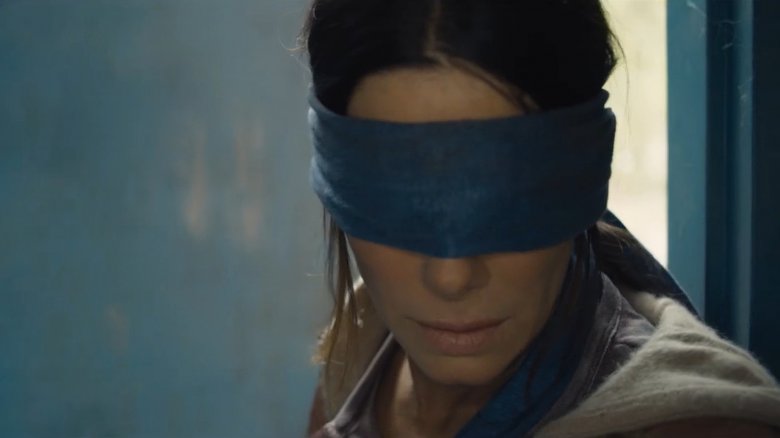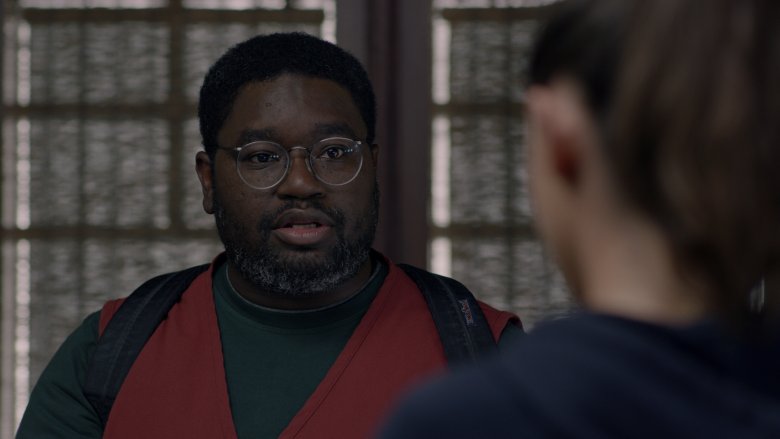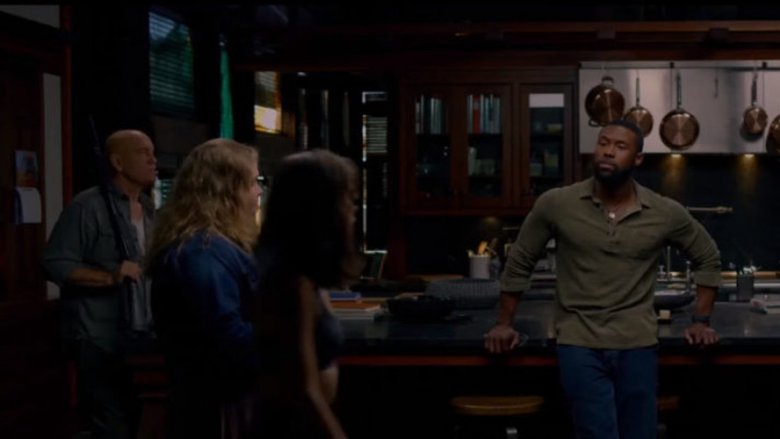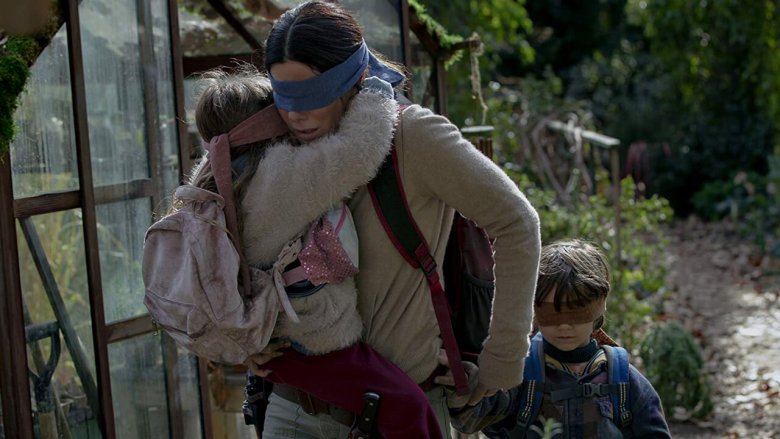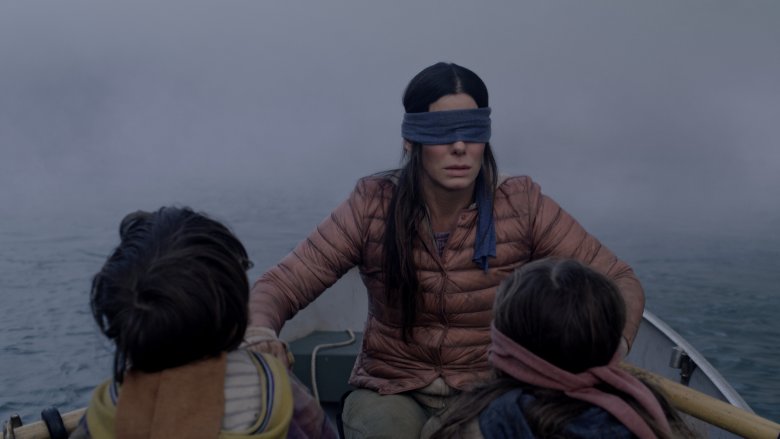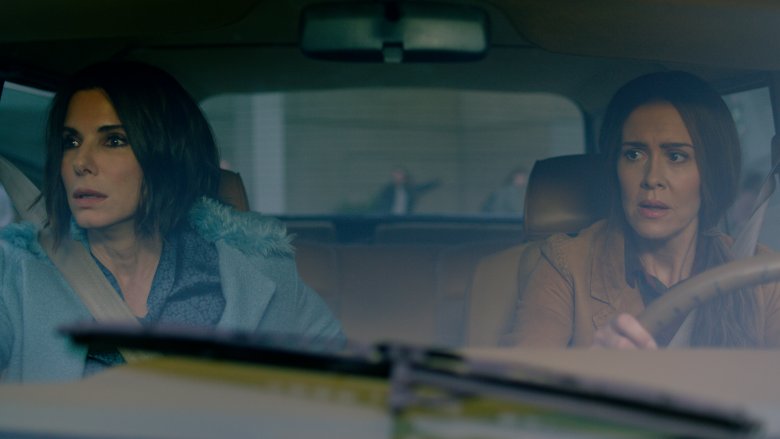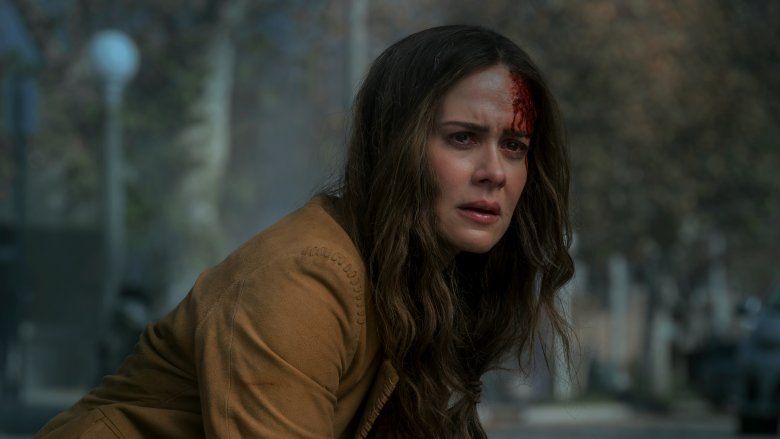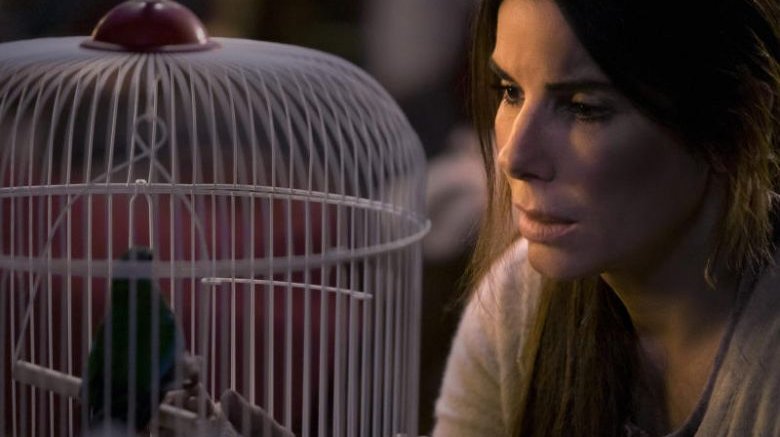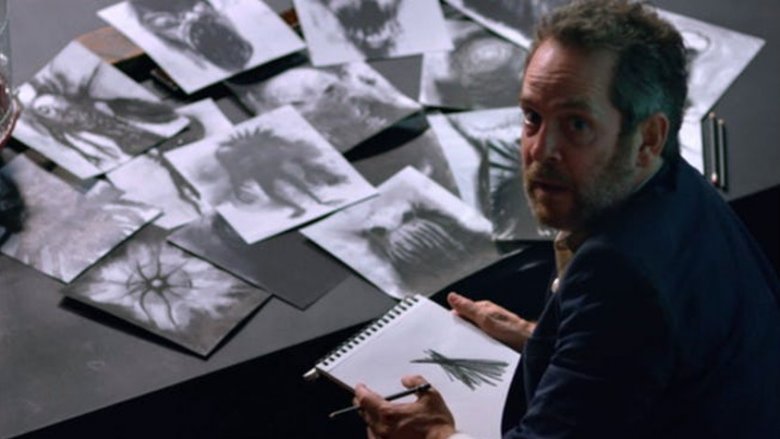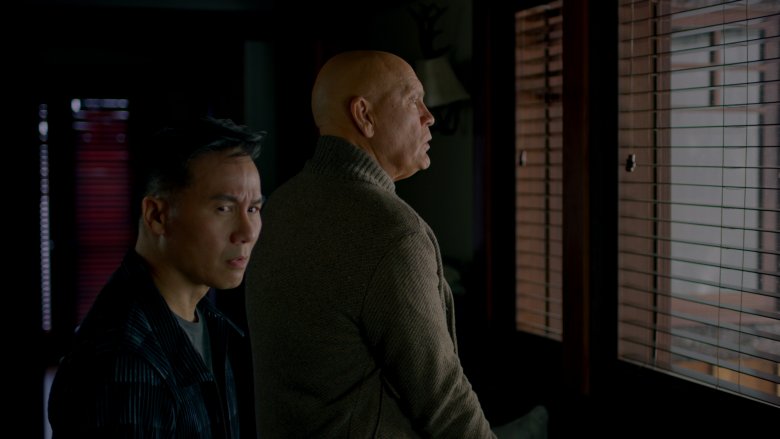The Ending Of Bird Box Explained
Bird Box is streaming on Netflix, giving viewers everywhere the chance to dive into a new post-apocalyptic nightmare. The film tells the story of Malorie (Sandra Bullock), a woman who manages to survive various stages of a devastating event in which mysterious creatures drive nearly everyone who sees them to commit suicide. With humanity decimated and the outside world unsafe, Malorie and the two children she cares for must make a terrifying journey down a treacherous river if they have any hope of reaching a safe haven and, she hopes, a new life. The film is a terrifying journey into a world where you can't trust your eyes, and it's packed with intriguing little details that you'll be thinking about long after the credits have rolled. So in celebration of all those little details and what they might mean, this is the ending of Bird Box, explained.
Oh, and SPOILERS AHEAD for the film.
The diet of monsters
One of the most frightening things about Bird Box is its willingness to tell us so little about what's really happening to the world, and to specifically tell us so little about the mysterious creatures plaguing humanity. We know that they drive most people to suicide and some people to madness by giving them some kind of visions, and that they are only able to do this when you see them. We know that their prevalence began in Eastern Europe and then seemed to spread throughout the world, but there's not much else we know for certain, and one of the things we definitely don't know is what they eat. Are these creatures feeding on the consciousness of the people they infect? Are they really, as Charlie (Lil Rel Howery) suggests, demons feeding on souls? Or are they simply herbivores who chow down in the natural world when we're not watching? The film doesn't offer any major clues, and it's just one piece of a much larger puzzle we're left to ponder.
The source of the problem
Another key element of the puzzle of the creatures is where exactly they came from, and why they arrived. This matters in the context of the film's ending because, like every other mystery about these creatures, it's something the remaining human survivors will be trying to piece together as they attempt to rebuild some semblance of a civilization. The problem seemed to begin in Europe before crossing into the United States, but that's our only real clue. They could be extraterrestrial creatures, weaponized forms of life created in a government lab, or demonic lifeforms conjured up by magicians. Anything seems as likely as anything else in the context of Bird Box, but each possibility brings to mind another key question: Do they reproduce? Are there are a finite number of these things, or will they just keep coming even if humanity can find a way to fight and kill them? Understanding the source might be the key to understanding how to drive them back to it.
A blind future
When Malorie, Boy/Tom (Julian Edwards), and Girl/Olympia (Vivien Lyra Blair) finally arrive at Rick's compound down the river, they discover that it's a school for the blind, complete with a bird sanctuary that serves as a kind of early warning system for the sighted residents to know when they need to find shelter or cover their eyes. It's a very good system and Rick and company seem to have built quite a little community there, but it also calls to mind a key long-term issue. If this is the status quo in the world right now, and these creatures will never truly go away, does that give blind people a genetic advantage for the future of the human race? If Rick and his students survived, other communities of blind people likely did as well, and they will be the ones who thrive and have a greater chance of successfully reproducing. If that's true, humanity could be headed for a future in which a lack of eyesight is better.
A race of madmen
There's another, more frightening alternative future for certain pockets of humanity, and that future lies in the people who somehow survived after seeing the creatures. Depending on who you talk to, these people were either already insane when they saw the creatures or were driven insane by contact with them, but in the wake of this contact they remain alive and very dangerous. They're not insane in the sense that they are incapable of rational behavior. Their primary goal seems to be converting others to looking at the creatures, by force if necessary, but they're also able to at least give the appearance of being reasonable, and even drive cars and carry on conversations, all with their eyes wide open. If these people are so convinced that everyone should see the creatures, it stands to reason that they would choose to reproduce and show their children as well, keeping the babies who didn't find ways to harm eventually harm themselves alive and raising a race of people who find the creatures "beautiful." That sets up a strange society in which humanity is divided into two very different sides.
A future for Malorie
The bird box of the film's title refers in a literal sense to the cardboard box Malorie uses to store her birds for the journey down the river as an alarm system for when the creatures or those influenced by them happen to show up. In a metaphorical sense, though, the bird box can be seen as Malorie's own heart, tensed up and locked away while she simply tries to survive the horrors of her life. When they finally arrive at the school for the blind, one of Malorie's first acts of relief and comfort is to open the box and release the birds to "be with their friends," and shortly after that she finally softens with her children, giving them real names as a sign that they're now about to live a better life. Throughout the film we see Malorie's growth as a leader, as a mother, and as a survivor, and now she's found a place where she doesn't have to be so harsh all the time as a means of staying alive. What will the future bring for her further development as a person? Will that strong sense of leadership continue in times of crisis, will she continue to soften, or will she find a balance?
Damage beyond sight
Rick's compound is a school for the blind, meaning the majority of the people there when the outbreak began were people who simply couldn't be influenced by the creatures' strange ability to drive people who see them mad. It's a clever plot development, and it makes sense in the context of what we know for certain about the creatures, but what about the other ways in which the creatures can influence humans? We see during the grocery store run that they're able to rock the car, which means they can affect the world in a more material way, and even when Malorie isn't looking at them, they're able to get inside her head and make her hear the voices of dead people. Can they do the same to the blind? Do they get stronger as they influence more people? Are the blind people truly safe in this world, or can the creatures ultimately find a way to influence them too? Only time will tell.
Other animals
The film makes it very clear after the visit to the supermarket that birds maintain some kind of connection to the creatures. They can sense when the creatures are near, and begin to go absolutely crazy in response to this proximity. This makes them a good warning system for humans, but the film never really addresses what happens to other animals who encounter the creatures. No domestic pets are present in the house full of survivors, and we don't really see any additional ones as time goes on, even though Malorie's sister Jessia (Sarah Paulson) was a horse enthusiast. Do dogs and cats also go crazy when the creatures are near? Are they driven to violence after seeing them? Josh Malerman's novel, on which the film is based, actually does address this, confirming that dogs are also driven mad by seeing the creatures, but the film leaves this unanswered. It's quite possible that in the world of the film, there are wild dogs now roaming the landscape just like there are wild humans, and that's a scary thought.
Fighting back
Bird Box is already drawing numerous comparisons to the hit film A Quiet Place, which is also about mysterious creatures who have slowly wiped out humanity, though these creatures find their victims by sound rather than sight. One thing A Quiet Place does that Bird Box doesn't is give its creatures a clear weakness by the end of the film, something that the humans can act on in their fight for survival. We know the creatures of Bird Box can manipulate the physical world around them in at least small ways, and that they can get inside the heads of their future victims by making them hear voices. What we don't know is if they can be physically harmed, and if so by what. At one point Tom (Trevante Rhodes) rams the car forward when they're surrounded by creatures, and nothing seems to happen, so perhaps they can't be hit. Can a certain kind of light harm them? Can sound? Will anything deter them? This is something Malorie and the other survivors will now have to research if they have any hope of fighting back.
The power of an image
Early in the film, as the survivors are trying to figure out how to learn about the creatures, Greg (BD Wong) volunteers to use his home's security cameras to track them, believing that perhaps seeing an image of these creatures is not the same as seeing the creatures themselves. He is wrong, and ultimately kills himself by thrashing around in the chair he's tied to until he splits his skull open. Later, Gary (Tom Hollander) reveals that he has a sketch book containing images of his own visions of the creatures, which Tom later sees to no effect. So, drawings do nothing, but moving images do. Is there a middle ground? Can you look at a still photograph of the creature and still be influenced, or do they have to be in motion? What about an infrared scan, if such a thing is possible, or an ultraviolet image? Is there any way to truly see these creatures in motion through any kind of known tracking technology without meeting a horrible fate? It's yet another thing the survivors will have to figure out.
